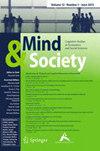当地环境中的寻路策略和方向感:探索性别差异
Q1 Arts and Humanities
引用次数: 0
摘要
导航是人类的基本行为,有研究报告称,男性和女性在地图上或基于计算机的模拟任务中定位目标时,在导航能力、策略和表现方面存在差异(男性更优)(Malinowski,2001;Astur、Ortiz 和 Sutherland,1998)。与此同时,很少有研究报告称,在建筑物内寻找通往目的地的路线这一任务中,如果地标始终存在,则没有性别差异。关于寻路策略的研究发现,男性和女性在定向策略上存在差异,男性更倾向于使用调查定向策略,强调距离、矢量和基本方向(如北、西),而女性则更倾向于使用基于路线的策略,利用地形特征(包括地标和相对方向)。有鉴于此,本研究旨在探讨寻路策略的性别差异。共有 112 名(53 名男生和 59 名女生)学生(平均年龄为 19.68 岁,年龄范围为 17-24 岁)参加了本研究,他们分别就读于巴加尔布尔提尔卡曼吉-巴加尔布尔大学的不同学院。独立 t 检验结果显示,在两种不同的寻路策略上存在明显的性别差异,男性更胜一筹,这表明根据具体情况,男性比女性更善于使用路线和定向策略。本文章由计算机程序翻译,如有差异,请以英文原文为准。
Wayfinding Strategies and Sense of Direction in Local Environment: Exploring Gender Differences
Navigation is a fundamental human behaviour and studies reported that males and females differ (favouring males) in their navigating abilities, strategies, and performance in locating targets either on the map or computer-based simulated tasks (Malinowski, 2001; Astur, Ortiz & Sutherland, 1998). At the same time, few studies reported no gender differences when landmarks were consistently present throughout the task of finding the route to the destination in the building. Studies on way-finding strategies found that males and females differ in their orientation strategies, where males preferentially use survey orientation strategies with an emphasis on distances, vectors, and cardinal directions (e.g. north, west) and Females, on the other hand, are in more favour of route based strategies using topographical features including landmarks and relative directions. Keeping in view, the present study is aimed to explore gender differences in wayfinding strategies. A total of 112 (53 male and 59 female) students (mean age 19.68 years and age range from 17 to 24 years) enrolled in the graduate course in different colleges of Tilka Manjhi Bhagalpur University, Bhagalpur participated in the present study. Independent t-test showed significant gender differences in two different wayfinding strategies favouring males, suggesting that males use route and orientation strategies better than females depending upon context.
求助全文
通过发布文献求助,成功后即可免费获取论文全文。
去求助
来源期刊

Mind and Society
Arts and Humanities-Philosophy
CiteScore
2.30
自引率
0.00%
发文量
5
期刊介绍:
Mind & Society is a journal for ideas, explorations, investigations and discussions on the interaction between the human mind and the societal environments. Scholars from all fields of inquiry who entertain and examine various aspects of these interactions are warmly invited to submit their work. The journal welcomes case studies, theoretical analysis and modeling, data analysis and reports (quantitative and qualitative) that can offer insight into existing frameworks or offer views and reason for the promise of new directions for the study of interaction between the mind and the society. The potential contributors are particularly encouraged to carefully consider the impact of their work on societal functions in private and public sectors, and to dedicate part of their discussion to an explicit clarification of such, existing or potential, implications.Officially cited as: Mind Soc
 求助内容:
求助内容: 应助结果提醒方式:
应助结果提醒方式:


